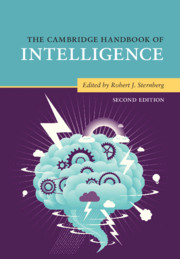Book contents
- The Cambridge Handbook of Intelligence
- The Cambridge Handbook of Intelligence
- Copyright page
- Dedication
- Contents
- Figures
- Tables
- Contributors
- Preface
- Part I Intelligence and Its Measurement
- Part II Development of Intelligence
- Part III Intelligence and Group Differences
- Part IV Biology of Intelligence
- Part V Intelligence and Information Processing
- Part VI Kinds of Intelligence
- Part VII Intelligence and Its Role in Society
- 37 Intelligence in Worldwide Perspective
- 38 Historical Evolution of Intelligence
- 39 Secular Changes in Intelligence
- 40 Society and Intelligence
- 41 Environment and Intelligence
- Part VIII Intelligence and Allied Constructs
- Part IX Folk Conceptions of Intelligence
- Part X Conclusion
- Author Index
- Subject Index
- References
40 - Society and Intelligence
from Part VII - Intelligence and Its Role in Society
Published online by Cambridge University Press: 13 December 2019
- The Cambridge Handbook of Intelligence
- The Cambridge Handbook of Intelligence
- Copyright page
- Dedication
- Contents
- Figures
- Tables
- Contributors
- Preface
- Part I Intelligence and Its Measurement
- Part II Development of Intelligence
- Part III Intelligence and Group Differences
- Part IV Biology of Intelligence
- Part V Intelligence and Information Processing
- Part VI Kinds of Intelligence
- Part VII Intelligence and Its Role in Society
- 37 Intelligence in Worldwide Perspective
- 38 Historical Evolution of Intelligence
- 39 Secular Changes in Intelligence
- 40 Society and Intelligence
- 41 Environment and Intelligence
- Part VIII Intelligence and Allied Constructs
- Part IX Folk Conceptions of Intelligence
- Part X Conclusion
- Author Index
- Subject Index
- References
Summary
There are large between-country differences in measures of economic and noneconomic well-being. Many researchers view increasing the stock of human capital as the key to raising economic development, promoting democratization, and improving health, and hence improving overall societal well-being. The single most studied aspect of human capital concerns cognitive competence. Differences in population cognitive competence might explain these societal differences. Evidence suggests that education builds cognitive competence, and education and cognitive competence promote better social outcomes, in terms of both economic and noneconomic factors. However, measuring population cognitive competence for countries requires representative samples, culture-fair tests, equivalency in the relationship between test measures and other cognitive attributes, and comparability in testing situations. In most cases, none of this has been achieved.
- Type
- Chapter
- Information
- The Cambridge Handbook of Intelligence , pp. 964 - 987Publisher: Cambridge University PressPrint publication year: 2020
References
- 1
- Cited by



